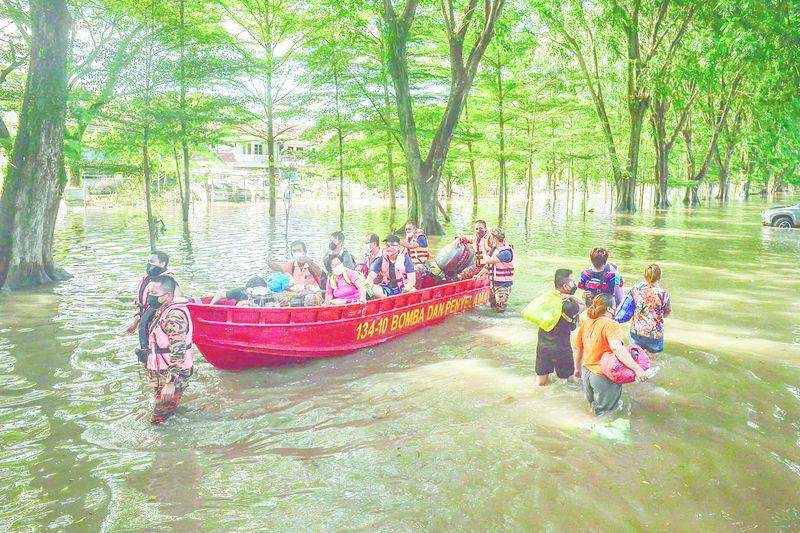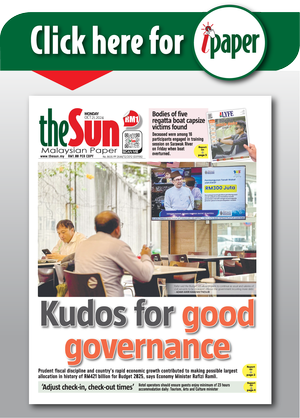ONE bright morning in 2004, a family was enjoying the lovely sea view and paid scant attention to a high wave fast approaching. That rolling wave was a harbinger of the deadliest tsunami to hit Asia in recorded history, killing 228,000 people.
This year, it is past mid-February and the prolonged wet spell is just ending. You hear small talk about climate change but the conversation soon veers off to focus on more arresting topics.
Malaysia’s attentiveness to climate change is borne out by numerous public surveys. In one survey, voters were asked to list the issues of concern in their order of priority. When the data was collated, it showed that voters had 16 issues. Cost of living and prices of goods invoked the highest concern. Everyone surely agrees.
Climate change and the environment are mentioned somewhere, but where? It was concern No.15, one rung above the bottom.
A survey by another think-tank showed eight issues of concern. Climate change was not one of them. The top concern was improving the country’s economy and tackling the cost of living.
Should we shrug off climate change, like the family ignoring the high wave? Perhaps that is
a sensible reaction because neither the politicians who steer the nation’s direction nor the religious professionals who guide their hands profess much interest. Are they right in their nonchalance or are they betraying the trust placed in them?
In this series, we shall present information on all relevant factors that we have gathered, analysed and synthesised holistically.
Our treatment differs from other contemporary analyses that regard biodiversity loss as a subset of climate change, when it should be viewed as a separate category because climate change and biodiversity loss are paired facets of the wider global ecological crisis threatening humanity – a situation that we are facing for the first time in the 300,000 years of human existence.
The information we collate is stacked in two piles like weights on opposing seats of a playground seesaw to provide clear indication for all Malaysians as to which direction we are heading – complete victory or defeat.
Movements of the seesaw are notated on a scale, with the numbers +1 to +10 on the right side, and -1 to -10 on the left side, with +10 points representing complete victory and -10 points representing complete defeat. Complete victory over climate change is the best-case scenario while complete defeat by climate change is the worst-case scenario.
Complete victory means the global ecological crisis ends its run; complete defeat means devastation for many countries, including Malaysia, if we accumulate -10 points and fail to pull up.
In addition to placing biodiversity loss in a category separate from climate change, our holistic measurement will also factor in certain deeply embedded personal, social and institutional patterns of behaviour – including the religious dimension – that exert a strong hidden impact on our handling of the global ecological crisis.
We invite you to join us in watching the seesaw movement as the climate crisis endangers your future.
This visual representation enables us to realistically grasp the state of humanity in a species-threatening situation.
Let us start by looking at the basic statistics. Throughout the 300,000 years of human existence until 1760 – the start of the Industrial Revolution – the carbon dioxide (CO2) level in Earth’s atmosphere has held steady at around 280 parts per million (ppm).
It then rose to 290ppm in 1879, some 120 years later. By 1910, it had reached 300ppm. In 1958, it stood at 315pm and it struck 320ppm in 1970. By 1979, it had reached 335ppm; and in 1992, it reached 356ppm. In 2013, it was measured at 400ppm; in 2020, it stood at 417ppm; and in 2022, it hit the threshold mark of 420ppm – a level not seen on Earth for about four million years.
In June 2024, the CO2 level peaked at 426.91ppm. That is 52.4% higher than during the pre-industrial era.
Scientists have zero doubt that the changes in CO2 levels were solely brought about by human activity, mainly the burning of fossil fuels and the extension of farmlands at the expense of forests and other natural ecosystems. Fossil fuels saw a transformation of the world economy that spurred a massive surge in human population.
In 1856, scientists tested the heating effects of CO2 in the air and proved that it contributed to global warming. In 1896, they discovered that the burning of coal or any other fossil fuels contributed to the global warming effect.
For causing global heating and adverse climate change, humanity lost one point. By the 1970s, it had already become widely known that fossil fuels were causing global warming and yet their use continued unimpeded despite the resultant increase of 12% in CO2 levels.
It was only in 1987 that an international agreement, called the Montreal Protocol, was signed to restrict the use of CFC (chlorofluorocarbons) and HCFC (hydrochlorofluorocarbons) chemicals that damage the ozone layer. For taking no action until 1987, humanity lost a second point.
However, it was only in 1992 that the Earth Summit was convened, at which 179 countries agreed to form the United Nations Framework Convention on Climate Change to lessen the threat of global warming and the global impact of climate change.
It took until 2015 before the UN Climate Change Conference set binding targets and commitments by 196 countries to limit global average temperature increases. For dragging its feet until 2015 when the CO2 level had already touched 400ppm two years earlier, humanity lost another point. The score now stands at -3.
What have been the effects of climate change up until the end of last year? The European Union’s Copernicus Climate Change Service confirmed that every month in 2024 was either the warmest or the second warmest on record for that month since global temperature records began.
Last year was the world’s hottest since records began, and each of the past 10 years was among the warmest on record. The impacts of climate change are now visible on every continent, affecting people from the richest to the poorest countries on earth.
Sharon Seah, coordinator of the Asean Studies Centre and Climate Change in Southeast Asia Programme, told the media in September last year: “Without fail, we have witnessed record-breaking extreme weather every year in almost all inhabitable parts of the world.” She warned that Southeast Asia was at the frontline of the climate crisis.
Delays result in loss of lives
The 2024 report of the Lancet Countdown on health and climate change shows that people all around the world are exposed to record-breaking threats from delayed action on climate change.
While climate threats grow, the risks to people’s health are being exacerbated by years of delays in the implementation of life-saving adaptation interventions.
The majority of indicators monitoring the health hazards, exposures and impacts of climate change have reached “concerning new records”, the report said.
These indicators include the significant increase in incidents or levels of: landslides and floods, heatwaves and droughts, heat-related deaths, transmission of dangerous infectious diseases, deforestation reducing the world’s natural ability to capture atmospheric carbon dioxide, and fuel-derived air pollution. Extreme weather cost thousands of lives in 2024.
Landslides and floods
Extreme precipitation events are becoming more frequent, threatening food and water security, sanitation, spreading infectious disease transmission and increasing the risk of landslides and floods.
A record 61.3% of the global land area saw an increase in the average number of extreme precipitation days per year in the latest decade compared with the 1961–1990 baseline.
Last April, the United Arab Emirates received two years’ worth of rain in a single day, turning parts of the desert state into a sea. In a matter of hours on Oct 29 last year, two rivers and one little stream turned into raging torrents, wiping out several small towns just south of Valencia city in Spain.
Malaysia also suffered an unprecedented series of floods last year, the intensity and frequency of which shattered all previous records and left 139,000 individuals displaced.
As of the end of January 2025, more than 10 locations in Sarawak were still affected by flooding. In Sabah, key routes including parts of the Sandakan-Kota Kinabalu highway remained blocked after several days of heavy rain.
Last year’s floods were, in the words of Deputy Agriculture and Food Security Minister Datuk Arthur Joseph Kurup, “exceptionally severe”. Up to December, the amount of padi lost was “equivalent to 5.84 million 10kg packs of rice,” he said.
More than 100ha of farmland, including vegetable plots, in five states were destroyed by the floods, resulting in a shortage of vegetable supply and increased prices by 50% to 80%. Due to the lack of flood disaster preparedness, Malaysia and the world lost one more point. The score now is -4.
Are we at the beginning of a perfect storm of stressors in our complex and globally interconnected societies? This series will examine all the causative factors.
Part two onwards will deal with topics including heatwaves and heat-related deaths, droughts, the rise of superbugs, deforestation and biodiversity loss, pollution, population and plastics.
But take heart. Our series will also highlight the climate actions that have been taken with technological innovations such as solar panels, hydro and hydrogen power and electric vehicles. These earn many plus points but are they enough to offset the minus points?
Joachim Ng champions interfaith harmony.
Comments: letters@thesundaily.com










